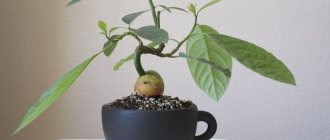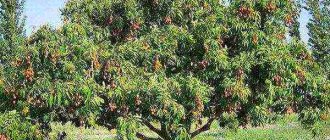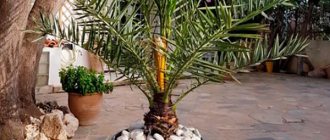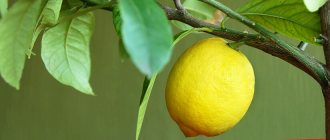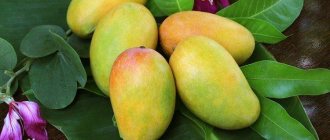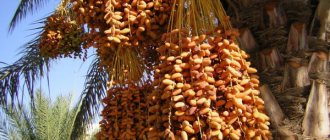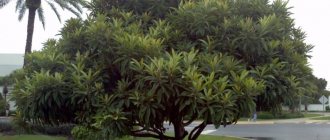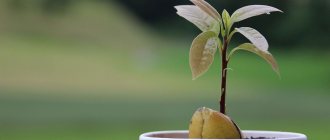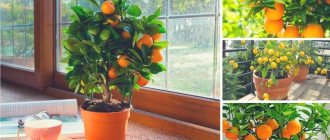Tangerines are an indisputable attribute and harbinger of the New Year. Citrus notes flow through the apartments in a magical trail, lifting the mood and bringing a sense of celebration even to the dullest day. Do you want aroma to excite you all year round? All you need is a few seeds, a pot of soil and a little persistence. How to grow tangerines at home, what to feed and when to plant? Consulting agronomist Vasily Opimakh, especially for AGRONEWS, broke down all the subtleties of the new trend - exotics on the windowsill.
Bury in the ground
It is better to select seeds for planting from real, non-hybrid tangerines. This way there is a greater chance of seeing fruit on the tree even without grafting.
— It can be difficult for amateurs to distinguish a hybrid tangerine. I advise you to stick to Abkhazian fruits. Seedlings from such “parents” will be more resistant to unfavorable conditions.
You need to plant the seeds as soon as you eat the tangerine. But even if they are dry, it’s not scary. Place the seeds in damp gauze for several days, and when the sprouts hatch, place them in the ground.
Preparation of planting material
Seeds for growing a tangerine tree can be taken from ordinary tangerines purchased in the store. For planting, you need to choose the largest ones: they will grow into strong seedlings with a well-developed root system. Small ones may not germinate at all. Another important condition is that the seeds must be taken fresh, just removed from the fruit. If they have time to dry out, you will wait a long time for shoots from them.
To make the seeds germinate faster, they need to be wrapped in a cotton pad (or cloth) soaked in water and kept for 5 days. When drying, the cotton wool needs to be additionally moistened. After 5 days, the seeds will swell and it will be easier for them to hatch. You can even germinate them by keeping them in a wet cotton pad for a few more days. But it is better that they still sprout while in the ground.
Advice! Even if you only want to plant one tangerine tree, plant at least 4-5 plants initially. Some of them may not sprout, while others may die due to infection. And then you will have 1-2 trees left.
The main thing is that the pot sits
When choosing land for planting, remember that tangerines do not tolerate acidic soil. The substrate can be purchased at the store. On the packaging, look for the mark pH = 6.5–7 (neutral soil). Or assemble the composition yourself, according to our expert’s recipe:
- Mix two parts humus, two parts field soil and one part sifted river sand. Even plastic cups are suitable as the first pot, but be sure to have a drainage hole. Excessive watering is dangerous - there is a risk that the sprouts will rot and die. The seeds are planted to a depth of about 1.5–2 cm. The optimal temperature for such crops is 20–25 ºC. If the room is cool, the germination period is delayed. If you follow all the recommendations, you will see results in three to four weeks.
For normal growth, seedlings need diffused light. It is better to place pots of tangerines in a room with windows facing south.
Choosing a variety of decorative tangerine
In order not to be disappointed and get fruits already in 4-5 years, you should approach the choice of the future plant correctly. Breeders have developed dwarf varieties of tangerines especially for home breeding. They require less care, grow quickly, bloom and bear fruit abundantly.
It is best to choose from the most unpretentious varieties:
- Pioneer: large fruits weighing about 90 g, low, branched crown;
- Sochi: the weight of each tangerine exceeds 80 g, thin-barked;
- Kawano-Wase: height - up to 1 m, bears fruit in the second year after planting, yield from one tree - 100-120 tangerines with a diameter of 5-7 cm each;
- Nova: fragrant flowers, sweet fruits, but difficult to peel;
- Unshiu: reaches 1.5 m in height, bears fruit in the third year, seedless.
The choice of variety depends on what conditions will be created for the full development of the plant.
Attention! You should not purchase tall specimens for a small room. The tangerine will need space and a large pot. It is better to grow very low-growing varieties on the windowsill, for example, Pioneer.
Replant it immediately
During the growing process, some seedlings may die. But natural selection will allow you to get strong shoots.
— After the seedlings grow up, they need to be replanted. Choose a new pot with a diameter 2–3 cm larger than the previous one. This way the plants evenly form the required ratio of above-ground and root mass. For young trees, the flowerpot is changed once a year. Those that already bear fruit no more than once every 2-3 years and only after harvesting.
Planting and propagating indoor tangerine
Creating ideal conditions for a plant is half the success. Mandarin loves the sun, but does not tolerate too high temperatures. It is demanding of moisture, but dies with excessive watering. It grows all year round, but requires winter dormancy to bear fruit.
Where to plant
The optimal place for a homemade tangerine is a window sill on the south or west side of the house. With short daylight hours, the plant needs additional lighting. A draft is detrimental to it, so the location is chosen taking into account the possibility of careful ventilation. You can’t often move the tangerine from place to place - there is a high probability of stress. Only once every two weeks is the pot with the plant rotated 10° so that the entire crown receives the same amount of ultraviolet radiation.
Important! In summer, the tangerine needs “walks” in the fresh air. If it is possible to keep it outside throughout the warm season, that’s good. The main thing is to protect it from the wind.
Requirements for soil and pot
Mandarin does not like acidic soils, so there should be no peat in the ground. It is best to purchase a special substrate for citrus fruits at a flower shop - it is ideal for growing a heat-loving southern plant at home. Soil acidity (pH) should not exceed 6.5-7 (usually it is indicated on the package with soil).
You cannot immediately plant a tangerine in a large pot - there is a great danger of waterlogging or acidification of the soil. To begin with, a container with a depth of 8-10 cm and a diameter of 7-8 cm is enough. Only when the root system fills the volume of the pot, do they transfer it to a larger one, increasing the diameter by 4-6 cm annually. Flowering and fruiting plants should not be replanted. Mature trees do not move at all, limiting themselves to updating the top layer of soil.
Reference. The material of the pot is not so important; it can be ceramic, plastic or wood. The main thing is that there are drainage holes for good soil aeration and protection from mold.
Growing from seed
The most labor-intensive process and unpredictable result. When growing tangerines from seeds, the plant does not bloom for a long time, and fruiting may not occur at all. The fruit will be smaller and have a different taste than the parent fruit. But it is interesting to observe the whole process from germination to ripening.
For germination, only healthy seeds are taken - they do not look dried out, without damage or black tops. The faster the grain gets from the tangerine into the ground, the better. But if this is not possible, the seeds are germinated in damp gauze.
Meanwhile, prepare the container. At the initial stage, even a 0.2 liter plastic cup with drainage holes pierced in the bottom will do.
Soil for citrus fruits is purchased at a flower shop, as it is guaranteed to be disinfected and has optimal acidity. Hatched or fresh seeds are deepened 4 cm into the soil. Provide moderate watering as the top layer of soil dries.
Important! Do not cover with jars or plastic. The plants tolerate home cultivation well, but greenhouse conditions are detrimental to them.
After 15-30 days (depending on the variety), the first shoots will hatch. When four leaves appear, the seedlings are transferred to pots with a diameter of 8-10 cm and a depth of at least 12-15 cm. If all the seeds have sprouted, they are placed in separate containers. It is best to plant at least 5-8 seeds. Firstly, not everyone will germinate. Secondly, for vaccination.
Tangerines grown from seeds take a long time to grow and require additional procedures:
- Crown formation. Only branches of the 4th-5th order bear fruit, so first pinch off the main shoot after reaching 35-40 cm in height. Then, as the side branches appear, they are cut off after the appearance of 5-6 leaves. The whole process takes 4-5 years.
- Feeding. It is best to fertilize with special mixtures for citrus fruits, but organic ones are also suitable. Tangerines respond well to mullein diluted in a ratio of 1:10.
- Hibernation. In order for the tangerine to begin to bloom, at the age of 5-6 years it needs seasonal dormancy at a temperature not higher than +10...+12°C and darkening for 3-4 months.
- Stimulation of flowering . If, after a period of winter dormancy, the tangerine does not bloom, perform the following procedure: copper wire is tightly tied to the lower part of the trunk, as a result of which the sap flow slows down and the plant blooms.
- Load control. For every 20 leaves, one flower or ovary is left. This way the plant will not be overloaded and will be able to bear fruit fully.
From seedlings
The most proven way to get guaranteed results. The seedlings are either grown from cuttings or already grafted. The most resilient and low-growing varieties are grown for sale. You can get a harvest already in 2-3 years (depending on the age of the plant). Their care is minimal: lighting in winter, timely watering and fertilizing.
From layerings
A good option for getting a home plant from exactly the variety you like. This can be done where tangerines grow in their natural environment.
Select a one-year-old branch 20-25 cm long and cut it obliquely with a sharp knife. The bottom of the layer is freed from bark and leaves, the top is pinched. Then wrap it in a damp, thick cloth, place it at an angle of 45° in a shallow dish and periodically add water. 2-3 weeks after the roots appear, the cuttings are transplanted into a pot with a diameter of 20-25 cm and a depth of 30 cm and placed in a permanent place.
Further care consists of regular watering, fertilizing with nitrogen fertilizers and crown formation. After 3-5 years (depending on the variety), the tangerine will need winter rest before flowering.
Beauty requires sacrifice
An important stage in growing citrus fruits is crown formation. The tangerine tree is pruned to speed up fruiting. Vasily Opimakh explains that if a seedling at a height of 30–40 cm flatly refuses to branch, the top should be pinched:
— This manipulation will force the plant to send out lateral branches. But this is not enough for flowering - it bears fruit only on branches of the 4th–5th order. To force the tree to share its harvest, the tips of the shoots are cut off behind the fourth leaf and weak branches are removed. Crown formation takes about 3–4 years.
What kind of pot is needed for homemade tangerine
The culture reacts painfully to transplantation, so ideally it is better to plant each seed in cups with a volume of 300-350 milliliters.
If this is not possible, then choose a container 7-10 centimeters deep, 10-15 centimeters wide and 40-50 centimeters long. Seeds are sown every 5 centimeters; in this case, the seedlings are easier to remove from the soil without damaging the roots.
A container for homemade citrus must have drainage holes. This will help avoid stagnation of moisture in the root zone.
Take part in water procedures
The tangerine tree loves moisture. The expert advises watering the plant 2–4 times a week, and only with settled water at room temperature.
— It’s easy to check whether the soil is dry: take a pinch of soil; if it crumbles in your hands and does not form a lump, it’s time to take a watering can. By the way, tangerines generally love humidity. Don't be lazy to spray them. In summer, such manipulations should be carried out 2–4 per day. If the tree is blooming, you need to work with the spray bottle very carefully - under no circumstances should water get on the buds.
Loves tangerine and sunshine. However, make sure that direct rays do not burn the leaves. To ensure uniform growth of the crown, the pot is rotated around its axis.
— The optimal rotation mode is once every 2 weeks by no more than 10 degrees. It is also important to observe the temperature regime. For an adult tangerine tree, the norm is from 15 to 18 degrees with a plus sign. In summer, the room should not be hotter than +30. If the tree has bloomed, the norm for the thermometer is +20-25, otherwise the buds will fall off.
Sowing seeds
You can grow tangerines from seeds by first soaking the seeds in gauze to swell.
The algorithm of actions is as follows:
- A piece of gauze folded in several layers is placed in a small container.
- Then fill it with a small amount of water to create a humid environment, and place it in a bright, warm place.
- As it dries, add water. The process usually takes two to three days.
Hydrogel can be an excellent alternative to gauze. It not only retains moisture well, but also contains the nutrients necessary for plants. The main thing is to make sure that the seeds do not lie on the surface, but are among the mass of balls.
Landing is carried out as follows:
- The swollen seeds are placed in the soil to a depth of about 2-3 cm and sprinkled on top.
- The soil surface is sprayed with a spray bottle.
- The pot is covered with cling film to create a microclimate and placed on the windowsill. The first shoots appear after 3 weeks.
Soaking seeds, planting and first shoots of tangerine
You can plant the seeds without first soaking them, but seedlings will appear much later.
Shock therapy
Often gardeners are faced with a problem: the tangerine tree has grown, but flatly refuses to bear fruit. Shock therapy will help bring him out of suspended animation.
— Change the microclimate in winter and take the plant out of its comfort zone. The air temperature should be lowered to +12 ˚С, watering should be reduced, but the soil should not be allowed to dry out. In spring, when the temperature rises to +15-18 ˚С, there is a chance that the tangerine will bloom.
Vegetable garden on the windowsill: soon in all apartments in the country! What problems do we face when growing pepper seedlings? Consulting agronomist Vasily Opimakh knows about this.
Difficulties arise already at the stage of seed selection and pre-sowing treatment. How to properly disinfect seeds, is it worth germinating and replanting them? Read the material.
We are looking for the necessary soil
Neutral soil for homemade exotics can be purchased at a specialty store or, if desired, prepared yourself. Peat cannot be added to its composition, as it oxidizes and does not retain water well, which can destroy the seedling. To make the soil mixture, you need to use two parts of high-quality humus and leaf soil, and another part of sand.
There is another proven recipe: three parts turf soil, one part leaf soil, one part rotted cow manure, the same amount of sand and a little clay. A drainage layer consisting of pebbles or fine expanded clay should be laid at the bottom of the container. On top of it, purchased or prepared soil is placed. Of the mixtures available in the store, we can recommend the neutral and nutritious “Rose”, as well as “Biohumus”.
Grafting tangerines
The tree will produce its first fruits in 5-6 years. But there is a nuance. In taste, aroma and size, they can differ significantly from their ancestor. In order to reap a good harvest in the future, he needs a grafting of a cutting from a varietal tangerine.
— Such surgical manipulations should be carried out during the period of sap flow and only on a plant whose trunk is no smaller in diameter than a pencil. At a height of 5-10 cm, you need to make a T-shaped cut on the tangerine bark. This place should be smooth, without knots, swelling or roughness. The length of the horizontal line is about 1 cm, and the vertical line is 3 cm. We bend the ends, insert the scion (as in a pocket, inserting the shield from top to bottom) and press the bark. We treat the joint with garden varnish and wrap it with electrical tape.
If the tangerine grafting is successful, the bud will take root within three weeks, the petiole of the leaf will turn yellow and easily fall off. If the “operation” fails, on the contrary, it will turn black.
Choosing a seed for planting
Selection rules:
- Hybrid tangerine varieties are best suited because they contain the largest number of seeds;
- a plus is the rapid germination, early flowering, in most cases the plants produce edible fruits and are easier to graft;
- you should choose from 5-10 pieces of seeds to get a couple of seedlings, and if you plan to graft the plant in the future, then from 10 or more pieces;
- In order not to make a mistake with the seeds, they inspect each seed.
Tangerine seeds should be:
- with convex sides;
- without a gray or black coating;
- non-hollow, dense.
Water will help you select seeds suitable for sowing. Seeds are placed in a filled container. Those suitable for sowing will drown, and empty ones will remain on the surface.
Uninvited guests. How to save a tangerine tree from pests?
Citrus pets at home can also get sick and even die from pests. One of the main “enemies” of the tangerine is the spider mite. Thin threads and light dots on the back of the sheet will give you a signal.
— To get rid of a dangerous insect, you need to thoroughly wash the greens with warm water and laundry soap and spray with an insecticide. The scale insect may also fall out of the blue. It is easy to calculate: by the sticky coating on the leaves. The folk method of fighting is a soap solution with kerosene: for 1 liter of water, 5 g of soap and 10 g of kerosene. Spray up to twice a week or use insecticides.
Planting and growing exotic plants on a windowsill is not so difficult. The main thing is to be patient and strictly follow all recommendations. Then the tangerine tree will delight you with citrus aromas all year round.
And if you have questions or want to suggest a topic for material, write to us at
Mandarin from the seed - analyzing the difficulties
Before you decide to grow a tangerine from a seed, you need to think: how much work are you willing to do to achieve the result, and what exactly do you want from the tree you are growing - just decorative or also fruit? Are you ready to wait? Mandarin from seed grows quite slowly. Do you agree to experiments? In order for the plant to bloom, it will take more than one year, and there are often cases that the tangerine does not bloom at all, then you will need to help it.
In addition, if a tangerine grown from a seed produces fruits, they are not similar to those from which the seed was taken (in order for the variety to be repeated, it must be propagated vegetatively - by cuttings, grafting). However, what happens, in any case, is pleasantly surprising!
What variety can you grow at home?
There are many varieties of decorative tangerine trees that can be successfully grown at home from seeds. They are not very tall, and their crown develops compact and neat. These varieties of tangerine trees have an oversized root system, so they do not need to be planted in large containers and can be displayed on windowsills. If the plant receives proper care, it bears a lot of fruit. This compact tangerine tree with miniature brightly colored fruits complements any interior well.
The following varieties of tangerine tree are suitable for growing at home from seeds:
- Emperor. The fruiting period of this variety of tangerines falls in December and January. At this time, the tree bears small fruits. They have thick skin, juicy flesh, and sweet taste.
- Calamondin. This variety of tangerine tree grows from a seed to only 100 centimeters in height. It has many miniature fruits, which reach only 3 centimeters in length.
- Unshiu. The attractive crown of the variety has a wavy structure. With the onset of flowering, the tangerine tree emits a delicate aroma with floral notes. Tangerines themselves grow small, they have no seeds, and they can be eaten.
- Citrofortunella. This variety of tangerine tree reaches a height of 1.5 meters. During flowering, it emits a rather bright aroma. The miniature fruits of this variety are not suitable for consumption.
These are decorative varieties, but breeders have also managed to develop hybrid species. Such tangerine trees are not so susceptible to mistakes during care and can be safely grown at home on your windowsill. These varieties are:
- Clementine. Breeders crossed a tangerine with an orange and got this variety. It has small, slightly flattened tangerines with sweet, juicy flesh and bright orange skin. The variety is most often grown due to its large number of advantages. For example, it tolerates short frosts well. The compact crown consists of miniature dense foliage, in the axils of which there are small thorns. Fruiting occurs from late autumn to early summer.
- Doll. Breeders crossed the kumquat variety with clementine and got a tangerine tree with a taste similar to a tangerine and a kumquat-like appearance. Its height is 1.5-2 meters. The fruits of the variety ripen in early January to late February.
- Paterno. This Mediterranean variety of tangerine tree reaches a short height. Its compact crown consists of narrow foliage and has no thorns. Bright orange tangerines have thin skin and sweet, juicy flesh. They appear in the spring.
- Tangerine. A 60-centimeter tangerine tree easily responds to short-term frosts and drought. Juicy, sweet tangerines have few seeds and thin skin. They appear in November-December.
Frequency of feeding and choice of fertilizers
There is no need to fertilize young tangerines—the tree can simply be transplanted into a larger pot. Adult plants are fed from spring to autumn. You can use ready-made fertilizers for the citrus family or get by with mullein diluted with water in a ratio of 1:10. Fertilizing is repeated once every 2 weeks.
If a transplant is planned, the plant is not fed 3 days before the planned event and wait 14 days from the date of the procedure. At the flowering and fruiting stage, the crop needs phosphorus, potassium and regular watering. The flowering tree is sprayed so as not to touch the flowers.
Shaping and care
If the tree does not begin to sprout branches on its own, then it is necessary to pinch the shoots after 4-5 leaves. After this procedure, the plant will begin to form side shoots of the first order. Flowers appear on branches of the fourth or fifth order; until then, the tree must be formed using the above method. On average, a tangerine takes 3 to 4 years to form. If the tree is grown solely for decorative purposes, then it requires regular watering. The soil should always be moist, but not flooded. For trees from which it is planned to remove fruits, it is necessary to arrange winter periods. The temperature in this case should fluctuate from 10 to 12 degrees, closer to the warm season it should gradually rise to 25 degrees. The tree loves sunlight and draws its leaves towards it. From time to time it needs to be turned the other side to give an even shape to the crown.
Problems when growing tangerines
Yellowing and falling leaves
This problem can have various causes. It is important not to rush, carefully analyze the condition of the plant and make the correct diagnosis. In adult tangerines, leaves may turn yellow and fall off due to their old age. But at the same time, the tree itself looks healthy and develops normally.
General lightening of the foliage may indicate insufficient lighting of the plants. In this case, you need to take care to move the tangerine closer to the light, or provide it with artificial lighting.
The shedding of tangerine leaves can begin due to too dry air (in the absence of regular spraying, especially during the heating season), improper replanting (when the root collar is deepened, choosing too large a pot), drafts. If one of these causes is detected, they simply need to be eliminated.
The drying and falling of the lower leaves of the tangerine, while the leaf begins to dry from the tip, is associated with regular waterlogging of the soil. This phenomenon occurs either as a result of excessive care, or because the pot is too large in relation to the seedling. In any case, the plant must be transplanted into an appropriate pot with fresh, loose (breathable) soil, after removing the rotten roots.
